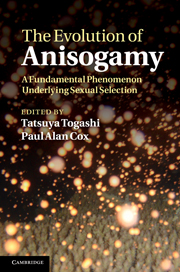Book contents
- Frontmatter
- Contents
- Contributors
- Introduction: The evolutionary mystery of gamete dimorphism
- 1 The origin and maintenance of two sexes (anisogamy), and their gamete sizes by gamete competition
- 2 The evolutionary instability of isogamy
- 3 Contact, not conflict, causes the evolution of anisogamy
- 4 Nucleo-cytoplasmic conflict and the evolution of gamete dimorphism
- 5 Adaptive significance of egg size variation of aquatic organisms in relation to mesoscale features of aquatic environments
- 6 Gamete encounters
- 7 Evolution of anisogamy and related phenomena in marine green algae
- Index
- References
Introduction: The evolutionary mystery of gamete dimorphism
Published online by Cambridge University Press: 19 May 2011
- Frontmatter
- Contents
- Contributors
- Introduction: The evolutionary mystery of gamete dimorphism
- 1 The origin and maintenance of two sexes (anisogamy), and their gamete sizes by gamete competition
- 2 The evolutionary instability of isogamy
- 3 Contact, not conflict, causes the evolution of anisogamy
- 4 Nucleo-cytoplasmic conflict and the evolution of gamete dimorphism
- 5 Adaptive significance of egg size variation of aquatic organisms in relation to mesoscale features of aquatic environments
- 6 Gamete encounters
- 7 Evolution of anisogamy and related phenomena in marine green algae
- Index
- References
Summary
We do not even in the least know the final cause of sexuality; why new beings should be produced by the union of the two sexual elements, instead of by a process of parthenogenesis.
Charles Darwin (1862)The mystery which Darwin struggled with, the existence of sex in the plant and animal kingdoms, continues to fascinate biologists today. While many plant and animal species reproduce sexually, others continue to succeed with asexual reproduction.
Consider, for example, Prorodon utahensis, a small animal which flourishes in the hypersaline waters of the Great Salt Lake (Figure 0.1). There are few other forms of life that can tolerate these salinities, which have been measured at up to 27%. The quivering hair-like cilia of Prorodon provide its tiny body – scarcely the width of a human hair – with sufficient locomotion to zip about its otherwise lethal environment, consuming organic detritius, cyanobacteria and the salt-tolerant green alga Dunaliella. In the shallow waters of the Great Salt Lake, which are too salty for fish, these tiny Prorodon are the major hunters, the equivalent of sharks at the microscopic level. Reproduction in Prorodon is a simple matter – it simply splits in half. Without resorting to sexual recombination, Prorodon is able to lock in its genetic combination for survival and success in this most hostile of environments. Asexual reproduction also grants Prorodon utahensis a significant numerical advantage in progeny. A single individual splits, producing two, then four, then eight, then sixteen, then thirty-two genetically identical offspring.
- Type
- Chapter
- Information
- The Evolution of AnisogamyA Fundamental Phenomenon Underlying Sexual Selection, pp. 1 - 16Publisher: Cambridge University PressPrint publication year: 2011
References
- 14
- Cited by



